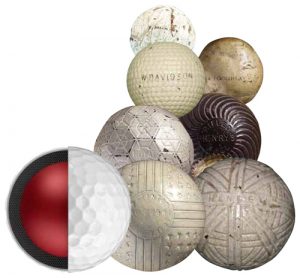 When golf was first played in Scotland in some form that would be familiar to us today, the ball might have been made out of wood, although this is speculation. A ball stuffed with hair in a leather pouch was played, and then the featherie became the norm. It consisted of wet feathers stuffed in leather. When the feathers dried, the ball expanded into a hard, playable sphere. The first mention of a featherie was in the 1600s, although there is evidence the ball was played at least 100 years prior.
The featherie lasted a long time, until the 1840s, when a Scottish divinity student named Robert Paterson came across a shipment of gutta percha and attempted to make some golf balls out of it. He was eventually successful, and as the gutta percha ball went farther, was more durable and cheaper than the featherie, the featherie’s long era came to an end. Gutta percha balls didn’t last long as in the 1890s, American businessman Coburn Haskell invented the wound golf ball, and in 1901 the Haskell Golf Ball Company was founded. The wound ball with a balata cover became the ball of choice for decades.
The balata ball was popular on the professional circuits until 2000, but in 1972 Spalding introduced the two-piece Top Flite golf ball with a Surlyn cover, revolutionizing the game yet again, especially for amateurs. Weekend warriors now had a durable ball that spun less and produced more distance. In 2000, Callaway Golf came up with the modern tour ball, the Rule 35, with a layered ionomer core and a urethane cover. Titleist and every ball manufacturer soon followed suit, and this construction is still considered premium.
OnCore Golf began as an idea in 2008 with a metal-core golf ball, another innovation, and since then has only grown bigger. Today the company has three balls, the Elixr, Vero X1 and the Avant 55 to appeal to all ranges of golfers. With OnCore and others leading the way, golf ball innovation is sure to continue.
When golf was first played in Scotland in some form that would be familiar to us today, the ball might have been made out of wood, although this is speculation. A ball stuffed with hair in a leather pouch was played, and then the featherie became the norm. It consisted of wet feathers stuffed in leather. When the feathers dried, the ball expanded into a hard, playable sphere. The first mention of a featherie was in the 1600s, although there is evidence the ball was played at least 100 years prior.
The featherie lasted a long time, until the 1840s, when a Scottish divinity student named Robert Paterson came across a shipment of gutta percha and attempted to make some golf balls out of it. He was eventually successful, and as the gutta percha ball went farther, was more durable and cheaper than the featherie, the featherie’s long era came to an end. Gutta percha balls didn’t last long as in the 1890s, American businessman Coburn Haskell invented the wound golf ball, and in 1901 the Haskell Golf Ball Company was founded. The wound ball with a balata cover became the ball of choice for decades.
The balata ball was popular on the professional circuits until 2000, but in 1972 Spalding introduced the two-piece Top Flite golf ball with a Surlyn cover, revolutionizing the game yet again, especially for amateurs. Weekend warriors now had a durable ball that spun less and produced more distance. In 2000, Callaway Golf came up with the modern tour ball, the Rule 35, with a layered ionomer core and a urethane cover. Titleist and every ball manufacturer soon followed suit, and this construction is still considered premium.
OnCore Golf began as an idea in 2008 with a metal-core golf ball, another innovation, and since then has only grown bigger. Today the company has three balls, the Elixr, Vero X1 and the Avant 55 to appeal to all ranges of golfers. With OnCore and others leading the way, golf ball innovation is sure to continue.
Copyright © 2023 United States Golf Teachers Federation, All Rights Reserved
200 S. Indian River Drive, Suite #206, Fort Pierce, FL 34950
772-88-USGTF or 772-595-6490 - www.usgtf.com
200 S. Indian River Drive, Suite #206, Fort Pierce, FL 34950
772-88-USGTF or 772-595-6490 - www.usgtf.com
